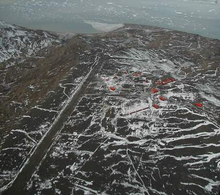Seymour Island
| Seymour Island | ||
|---|---|---|
| Waters | Wedell Sea | |
| Archipelago | Ross Islands | |
| Geographical location | 64 ° 14 ′ S , 56 ° 37 ′ W | |
|
|
||
| length | 19.2 km | |
| width | 8.8 km | |
| surface | 100 km² | |
| Highest elevation | Blackrock Ridge 187.3 m |
|
| Residents | 75 ward staff (winter) (2010) <1 inh / km² |
|
| main place | Marambio station | |
| Seymour Island (No. 8) within the island chain at the tip of the Antarctic Peninsula (No. 1) | ||
The Seymour Island ( English Seymour Island , Spanish isla Seymour or isla Marambio ) is located in the Weddell Sea , southeast of the northern tip of Grahamland on the Antarctic Peninsula .
location
The island is located just a few kilometers northeast of Snow Hill Island and east of James Ross Island . It is 2.5 to 8.8 km wide and 19.2 km long, and has an area of about 100 km². It was discovered in 1843 by the British navigator Sir James Clark Ross . He named the island after the rear admiral and later naval admiral Sir George Francis Seymour (1787-1870).
The island is sometimes called isla Marambio after the Argentine base located there in Argentina . The scientists there are concerned with a. with the polar light ( Aurora australis ), with meteorology, properties of the ionosphere , glacier science, cosmic rays and the monitoring of the ozone content of the stratosphere .
In Penguins Bay on the south coast of the island is a wooden plaque , by the crew of the Argentine corvette Uruguay was built on the spot where they two participants of the missing on November 10, 1903 Swedish Antarctic Expedition led by Otto Nordenskjöld met . The plaque and a cairn built in 1990 stand as a historic site and monument HSM-60 under the protection of the Antarctic Treaty .
climate
The climate on Seymour Island is cold and dry. At the Marambio station the mean temperature over the year is −9.1 ° C, in December, the warmest month, it is −1.7 ° C and in July, the coldest month, it is −15.2 ° C. The strong winds and low rainfall ensure that the surface of the island is mostly free of snow.
Fauna
BirdLife International has designated an area of 294 hectares in the Penguin Cape of Seymour Island as an Important Bird Area (AQ070). In addition to large colonies of Adelie penguins ( Pygoscelis adeliae ) breed on the island of Seymour and the Antarctic Tern ( Sterna vittata ), the Kelp Gull ( Larus dominicanus ), the Antarctic skua ( C. maccormicki ), the Brown Skua ( Stercorarius antarcticus ), the Wilson's Storm Petrel ( Oceanites oceanicus ) and the snow petrel ( Pagodroma nivea ).
The Norwegian captain Carl Anton Larsen found fossils on the island in 1892 . Since then, like the neighboring James Ross Island , the island has been a preferred place for paleontological field research , especially because the deposits manifest the KT limit , which was associated with mass extinction. Countless fossils have been discovered on the island, including extinct plants, invertebrates , mosasaurs , plesiosaurs , fish, crocodiles , marsupials , whales and penguins . In 2011, Chilean researchers found an object later identified as a fossil egg on Seymour Island . This is the second largest egg found so far and the largest with a soft shell. It is believed to be related to extinct marine reptiles (mosasaurs or plesiosaurs).
Web links
- Seymour Island at the Australian Antarctic Data Center (English)
- Polar cruises
Individual evidence
- ↑ a b Montalti, Diego & Soave, Guillermo E. The Birds of Seymour Island , Ornitologia Neotropical 13, 267–271, 2002 (PDF; Spanish; 344 kB)
- ↑ HSM 60: Wooden pole and cairn (I), and wooden plaque and cairn (II), both located at Penguins Bay, southern coast of Seymour Island (Marambio), James Ross Archipelago in the Antarctic Protected Areas Database on the Secretariat's website of the Antarctic Treaty (English, Spanish, French, Russian), accessed November 16, 2019
- ^ RI Lewis Smith: The vegetation of Cockburn island, Antarctica . In: Polar Biology 13 1993, pp. 535-542 (English)
- ↑ a b Penguin Point, Seymour Island (AQ070) in the Data Zone at BirdLife International, accessed on July 22, 2018 (English).
- ↑ a b Sankar Chatterjee: Late Cretaceous marine vertebrates from Seymour Island, Antarctic Peninsula . In: Antarctic Journal 17, 1982, p. 66 (English)
- ↑ Goin, Francisco J .; et al. (Dec 1999). New Discoveries of "Opposum-Like" Marsupials from Antarctica (Seymour Island, Medial Eocene). Journal of Mammalian Evolution. 6 (4): 335-365. doi: 10.1023 / A: 1027357927460
- ^ BJ Marples: Fossil penguins from the mid-Tertiary of Seymour Island , Falkland Islands Dependencies Survey Scientific Reports No. 5, 1953 (English)
- ↑ Lucas J. Legendre, David Rubilar-Rogers, Grace M. Musser, Sarah N. Davis, Rodrigo A. Otero, Alexander O. Vargas, Julia A. Clarke: A giant soft-shelled egg from the Late Cretaceous of Antarctica. Nature (2020), doi: 10.1038 / s41586-020-2377-7
- ↑ Researchers find the second largest egg in the world in Antarctica . In: Der Standard , June 19, 2020, accessed on June 20, 2020.


